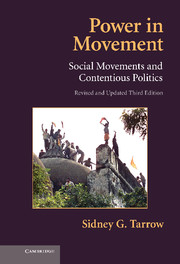Book contents
- Frontmatter
- Contents
- List of Figures
- List of Tables
- Preface
- Acknowledgments
- Introduction
- 1 Contentious Politics and Social Movements
- PART I THE BIRTH OF THE MODERN SOCIAL MOVEMENT
- PART II POWERS IN MOVEMENT
- PART III DYNAMICS OF CONTENTION
- 9 Mechanisms and Processes of Contention
- 10 Cycles of Contention
- 11 Struggling to Reform
- 12 Transnational Contention
- Conclusions: The Future of Social Movements
- Sources
- Index
- Titles in the series
9 - Mechanisms and Processes of Contention
Published online by Cambridge University Press: 05 June 2012
- Frontmatter
- Contents
- List of Figures
- List of Tables
- Preface
- Acknowledgments
- Introduction
- 1 Contentious Politics and Social Movements
- PART I THE BIRTH OF THE MODERN SOCIAL MOVEMENT
- PART II POWERS IN MOVEMENT
- PART III DYNAMICS OF CONTENTION
- 9 Mechanisms and Processes of Contention
- 10 Cycles of Contention
- 11 Struggling to Reform
- 12 Transnational Contention
- Conclusions: The Future of Social Movements
- Sources
- Index
- Titles in the series
Summary
In Part II of this book, we moved progressively through four of the main powers in movement:
In Chapter 5, we saw that it is disruption – not violence or convention – that characterizes the most vital insurgent movements. But movements that rely only on disruptive mass action risk slipping into violence and conflict with the police, while those that adopt conventional forms of action may suffer from cooptation of their goals and decline, as the public becomes bored and activists defect.
In Chapter 6, we saw that social movements depend to a varying extent on three levels of organization: the social networks at their base, the organization of collective action, and some degree of formal organization – however rudimentary. The key to movement dynamism is the social networks that lie at the heart of formal organization and can survive even when these organizations disappear or are repressed.
Chapter 7 showed that collective action is constructed not only out of organizations, but also out of cognitive frames, collective identities, and emotion work. An uneasy balance is always present between inherited – but passive – mentalities, and action-oriented – but unfamiliar – transformative frames.
Finally, in Chapter 8, we saw that movements form in the context of widening opportunities and collapsing constraints, but in making opportunities for others, for opponents, and for elites, movements may create the conditions for their own irrelevance or repression.
- Type
- Chapter
- Information
- Power in MovementSocial Movements and Contentious Politics, pp. 183 - 194Publisher: Cambridge University PressPrint publication year: 2011



